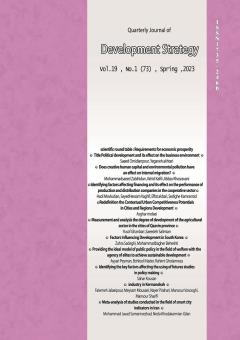-
-
List of Articles
-
Open Access Article
1 - Title Political development and its effect on the business environment
saeed omidianpour yeganeh akhtari -
Open Access Article
2 - Does creative human capital and environmental pollution have an effect on internal migration?
mohammad saeed zabihidan Vahid Kafili Abbas Khosravani -
Open Access Article
3 - Identifying factors affecting financing and its effect on the performance of production and distribution companies in the cooperative sector
Hadi Movludian seyed hesam vaghfi Effat Akbari Sedighe Kamranrad -
Open Access Article
4 - Redefinition the Contextual Urban Competitiveness Potentials in Cities and Regions Development
Asghar Molaei -
Open Access Article
5 - Measurement and analysis the degree of development of the agricultural sector in the cities of Qazvin province
Yousef ghanbari Saeedeh Salimian -
Open Access Article
6 - Factors Influencing Development in South Korea
zahra Sadeghi Mohammadbagher Beheshti -
Open Access Article
7 - Providing the ideal model of public policy in the field of welfare with the agency of elites to achieve sustainable development
پیمان عیاری نادر بهلولی غلامرضا رحیمی -
Open Access Article
8 - Identifying the key factors affecting the using of futures studies in policy making
Sahar Kousari -
Open Access Article
9 - Investigating the economic development components of the tourism industry in Kermanshah
Fatemeh Jalaeipour میثم موسائی nayereh pirahari mansour vosooghi Mansour Sharifi -
Open Access Article
10 - Meta-analysis of studies conducted in the field of smart city indicators in Iran
Mohammad javad samani nezhad neda khodakaramiangilan
-
The rights to this website are owned by the Raimag Press Management System.
Copyright © 2017-2025







